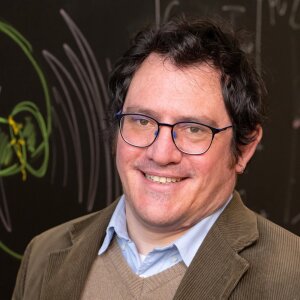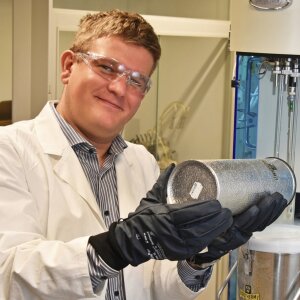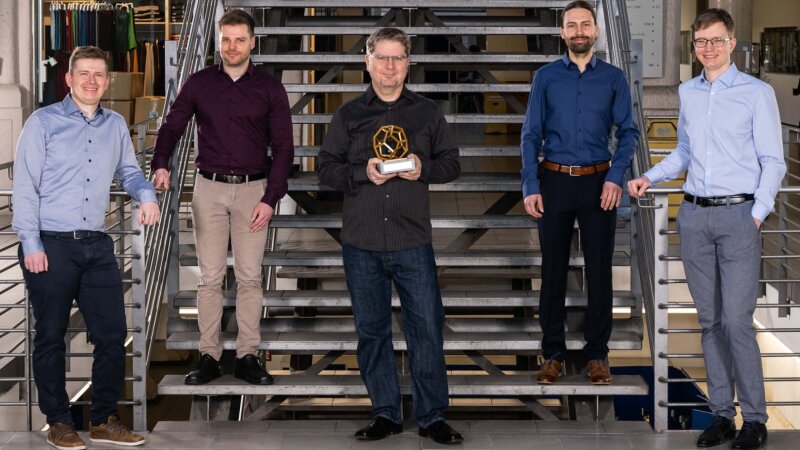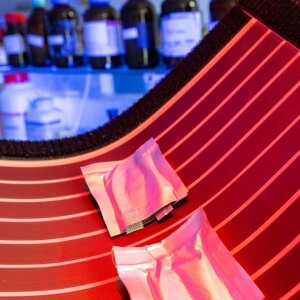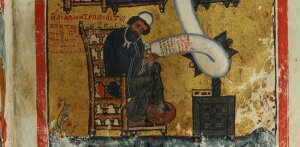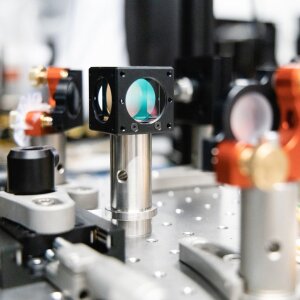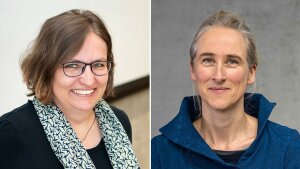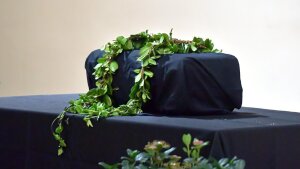News
Prof. Dr Sebastiano Bernuzz from the Institute of Theoretical Physics at the University of Jena.
Image: Jens Meyer (University of Jena)They are among the most extreme and most complex events in the universe: collisions of neutron stars. When two of these highly compact and massive celestial bodies merge, space-time becomes highly distorted and high-energy radiation and matter are hurled into space. The collision is so violent that it can be observed from Earth – even over millions of light years – as both gravitational waves and light.
»Such events are unique astrophysical laboratories,« says Prof. Dr Sebastiano Bernuzzi (photo). The 40-year-old researcher and his team from the Institute for Theoretical Physics are developing theoretical models with which the dynamics of such cosmic collisions can be understood. For his research project, “InspiReM”, Sebastiano Bernuzzi is receiving funding from the European Research Council (ERC) – a Consolidator Grant totalling almost two million euros over the next five years.
Bernuzzi was already funded with an ERC »Starting Grant« in 2017. His working group is a leader in the field of numerical simulation of neutron star mergers. To this end, the researchers use Germany’s largest supercomputers to make detailed predictions for gravitational waves and electromagnetic observations emanating from such events, by solving Einstein’s theory of general relativity. »By simulating what happens to space-time as stars merge, we can create detailed models for interpreting the radiation we observe.«
Just recently, Bernuzzi was part of an international team analysing data taken by NASA's Chandra X-ray Observatory in object GW170817. [US]
Prof. Dr. Martin Oschatz, Chair of Chemistry of Materials for Energy Application, Institute of Technical Chemistry and Environmental Chemistry, CEEC Jena.
Image: Anne Günther (University of Jena)The chemist Prof. Dr Martin Oschatz (photo) wants to develop new concepts for catalysis within the framework of the »CILCat« project and is being supported with a Starting Grant from the ERC in the amount of approx. 1.5 million euros. The production of almost all basic chemicals and the products derived from them is based on the principle of catalysis. The principle of what is called heterogeneous catalysis is based on the fact that small particles such as molecules or ions bind to the surfaces of solid substances.
The particles are »activated« by this interaction, which means that their conversion into other substances is accelerated. »However, rare metals are often needed for catalytic processes,« says the 34-year-old, describing one challenge that he wants to tackle in his research project to develop catalytic forms that do not require rare, expensive or toxic metals. The goal and the hopes associated with it are to make chemistry and its processes more sustainable and less harmful. [AB]
Flexible organic solar cells and polymer batteries are presented by Dr Martin Hager.
Image: Jens Meyer (University of Jena)The »FuncHeal« led by Prof. Dr Ulrich S. Schubert has been awarded funding by the German Research Foundation (DFG) worth more than 3.5 million euros over the next four years. The aim is to develop a new generation of self-healing materials, which can not only repair mechanical damage, but also restore functional properties.
Materials developed by the new Jena research unit are to be used primarily in flexible energy storage and conversion materials. Unlike in previous approaches to self-healing materials, the aim is not only to heal cracks and other types of mechanical damage. It should also be possible to restore functions and properties in a targeted manner, for example the conductivity of electrode materials in batteries or the optical properties of organic solar cells.
For example, organic, flexible solar cells (photo) are damaged by incident light over time, so that they are no longer able to convert solar radiation into electricity. In the FuncHeal project, the researchers in Jena want to find ways of ensuring that the molecular structure of the materials in the solar cells is restored, so that they regain their functionality. [US]
Elias of Crete writes a commentary on Gregory of Nazianzus.
Image: Universitätsbibliothek Basel, AN I 8, fol. c, DetailOver the next five years, the German Research Foundation (DFG) will be providing more than twelve million euros in funding for two new research training groups at the University of Jena.
The first new research training group, entitled »Materials-Microbe-Microenvironment: Antimicrobial biomaterials with tailored structures and properties«, will bring together researchers from the fields of physics, chemistry, biology, clinical medicine and microbiology from the University of Jena and Jena University Hospital. The aim is to develop a tailored platform for antimicrobial biomaterials to better prevent infections associated with biomaterials. The research training group will be headed by materials expert Prof. Dr Klaus Jandt and physician Prof. Dr Bettina Löffler.
The second new research training group, »Autonomy of Heteronomous Texts in Antiquity and the Middle Ages«, will focus on texts that take on older texts and reproduce and update their content in a new form, including commentaries, sermons, retellings, and paraphrases. These texts can be found in all classical disciplines: philosophy, literature, jurisprudence, medicine, and Jewish, Christian, and Islamic theology. Prof. Dr Katharina Bracht and Prof. Dr Matthias Perkams are the spokespersons for the research training group.
An extension has been granted for »Tree Diversity Interactions: The role of tree-tree interactions in local neighbourhoods in Chinese subtropical forests«, a research training group with members from the University of Halle-Wittenberg, the University of Jena, Leipzig University and Chinese partners. [AB]
Experimental setup in a quantum photonics laboratory.
Image: Steffen WaltherThe first national centre for quantum photonics has opened at the universities of Ulm, Stuttgart, and Jena. The centre has received twelve million euros in funding from the Carl Zeiss Foundation and will offer around 50 scientists a cross-location and multi-discipline platform for research and exchange.
Photonics is a key technology in the field of quantum science. Photons are used as sensor elements, data transmitters and quantum systems. The networking of quantum technologies and photonics forms the basis of the »QPhoton« centre. The aim is to develop a new generation of imaging and sensor technologies with greater sensitivity and faster data processing. [PM]
Portraits of Prof. Dr Christiane Kuller (University of Erfurt) and Prof. Dr Kim Siebenhüner (University of Jena).
Image: Hamish John Appleby / Jens MeyerThe issue of »colonial legacy« is currently generating a great deal of debate, not only in Thuringia. Christiane Kuller explains what motivated the historians to set up the coordination office: »We wanted to respond to the increased interest shown by educational institutions, the media and civil society in our colonial past«.
The aim is to raise awareness of the contribution that universities can make to the social debate. »Moreover, we already have research projects, courses, and lecture series on the topic. So, the initiative basically builds on existing expertise«.
Networking research activities in collections
Kim Siebenhüner points out the special importance of university collections when it comes to dealing with colonial legacy. The exact number of objects with a colonial connection is still unknown. »But the activities that are being carried out to get to the bottom of this are largely unconnected. This means that we can’t systematically work through the research questions by tapping into the great potential of structured scientific exchange and the synergistic bundling of processes«. This situation gave rise to the idea of networking and further expanding the activities carried out by the universities of Erfurt and Jena with regard to research, teaching and social discourse.
Over the next three years, the coordination office will set up a network for scientific exchange that will not only focus on scientists but will also include civil society initiatives and other groups with post-colonial goals. The coordination office is also planning to cooperate with museums and archives, educational institutions such as the State Centre for Political Education, memorial sites, and schools.
To name a concrete example, there will be a regular colloquium involving representatives of the universities of Erfurt and Jena, where current university and non-university research work will be presented and discussed. In addition, the researchers want to highlight the current »gaps in their knowledge« and create a map of colonialism in Thuringia. Ideas for courses, for Master's and qualification theses and for cooperative third-party funded projects are to emerge from this. Objects and analyses will be presented on a website or in an anthology connecting science and »public science«. And last but not least, the work will be presented in public lectures, in a blog and on social media channels. [C. Voigt]
Iwi kupuna during a repatriation ceremony in the university assembly hall in February 2022.
Image: Jürgen Scheere (University of Jena)Newly formed working group on colonialism
A scalp from Namibia, skulls from Tanzania and Papua. These are examples of human remains from collections at the University of Jena that were brought to Germany during the colonial period. Extensive research has been necessary to uncover the precise origins and history of these human remains, as identification is nearly always difficult and labour-intensive. The University of Jena has been involved in such provenance research for years.
For some months now, the working group »Colonial Heritage and Education Critical of Racism« has been deployed to study this topic, which includes the historians Joachim Bauer and Stefan Gerber, biology educationalist Uwe Hoßfeld and Archaeologist/Anthropologist Enrico Paust, and receives support from collection staff and other areas of the university.
The team of experts has recently produced new results, which it has published under the title »Ernst Haeckels koloniale Schädel«. Using eight skulls from the former Osteological Collection and the Phyletic Museum as examples, the publication shows the routes taken by such objects from collections in the 19th and 20th centuries, as well as the possibilities and limits of reconstructing their provenance a century later. [AB]
